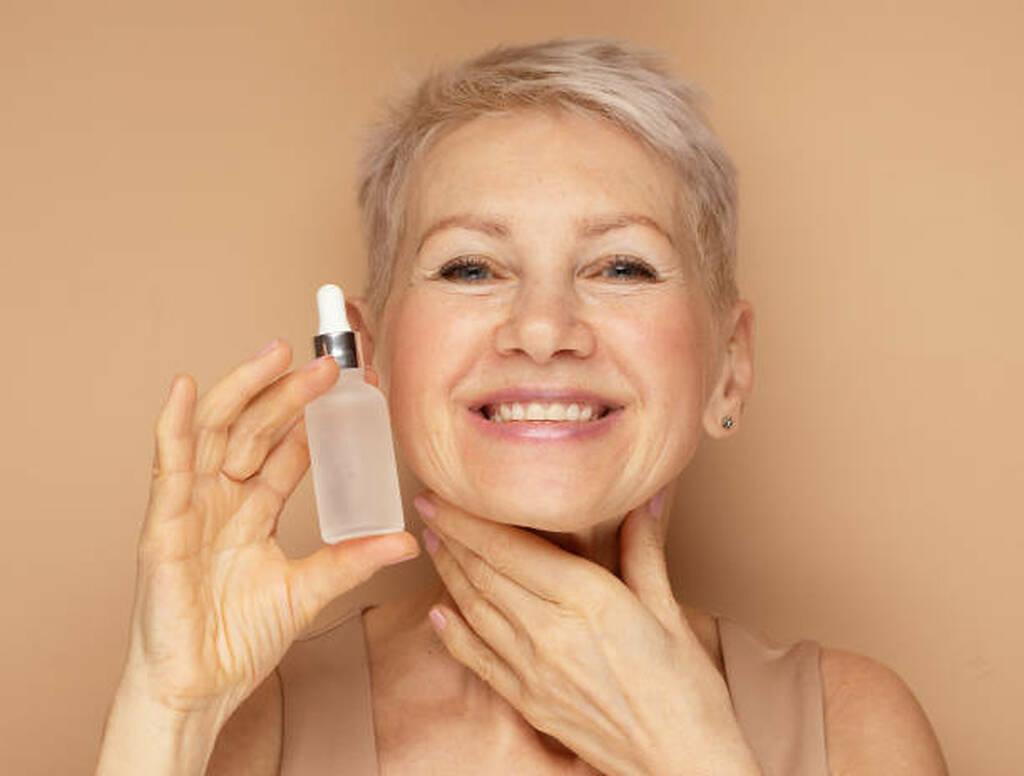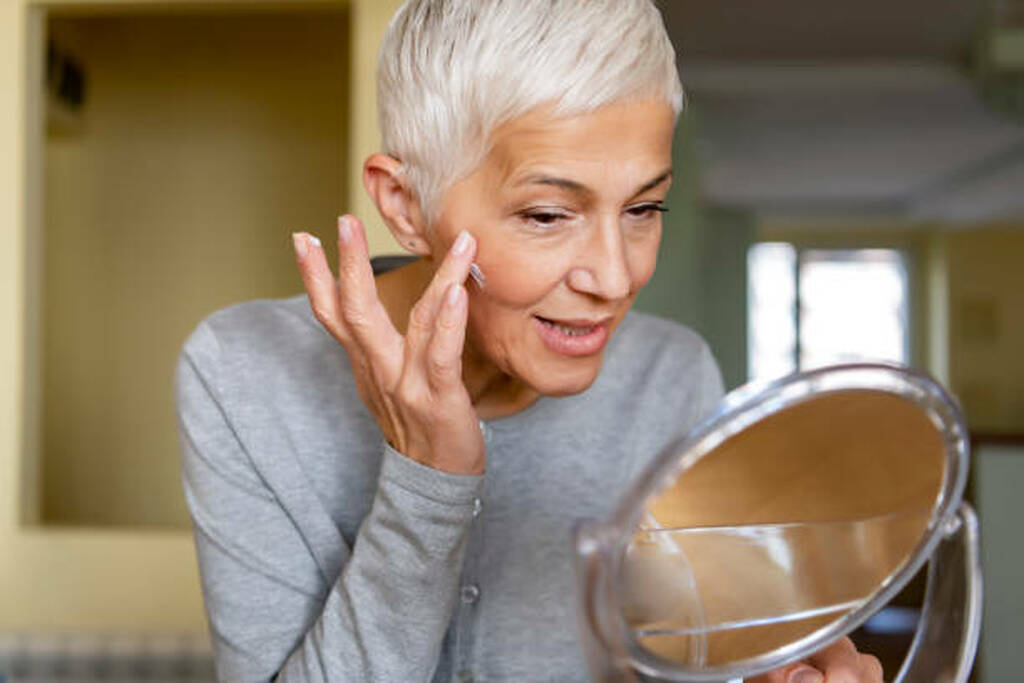Let’s talk about something that probably keeps you up at night—literally staring at your bathroom mirror wondering when your favorite moisturizer stopped working its magic. One day you’re glowing, and the next? Your skin feels like it belongs to a completely different person.
Here’s the thing: your skin after 50 isn’t betraying you—it’s just playing by different rules now. Those hormonal shifts hit hard, collagen production decides to take an extended vacation, and suddenly everything feels drier than the Sahara. The products that worked like a charm in your 30s and 40s now just sit on your face doing absolutely nothing.
But here’s my promise: this routine is specifically designed for mature skin’s unique needs—thinner texture, slower cell turnover, less natural oil production, and all the fun stuff that comes with fabulous and fifty-plus. I’m breaking down 7 essential steps for skincare routine for women over 50 that actually work. No complicated 15-step routines that require a PhD in chemistry.
And listen—consistency beats perfection every single time. You don’t need to nail this routine perfectly from day one.
Why Your Skin Needs a Different Skin Routine After 50
Ever wonder why your dermatologist keeps saying “your skin is changing”? Menopause throws a massive wrench into everything. Decreased estrogen means less collagen, less elastin, and way less natural plumpness. Cell regeneration slows from 28 days to 45-60 days.
Your oil glands basically go on strike, leaving tight, uncomfortable skin that drinks up moisture like it’s been stranded in the desert. All that sun damage you accumulated? It decides now is the perfect time to make its grand appearance.

But here’s the good news: once you understand what your skin needs, you can give it exactly that.
Step 1: Gentle Cleansing

Stop right there if you’re still using that foaming cleanser that makes your face feel “squeaky clean.” That tight, stripped feeling? That’s not clean—that’s damaged.
Why It Matters
Your skin after 50 desperately needs every drop of natural oil it can produce. Harsh cleansers with sulfates and aggressive surfactants strip away your skin’s protective barrier, leaving it vulnerable, irritated, and even drier than before. Your skin barrier is already working overtime—don’t make its job harder.
Advertisement
What to Look For
Switch to cream or oil-based cleansers that melt away dirt and makeup without declaring war on your face. Look for pH-balanced formulas (around 5.5) that respect your skin’s natural acidity. Ingredients like glycerin, ceramides, and natural oils are your friends here.
Avoid anything that lists sodium lauryl sulfate (SLS) or sodium laureth sulfate (SLES) in the first few ingredients. These are the culprits making your face feel like parchment paper.
How to Do It
Advertisement
Morning routine: Here’s a controversial take—you might not even need cleanser in the morning. If your skin feels fine, splash some lukewarm water and move on. Your skin produced beneficial oils overnight; why wash them away?
Evening routine: This is where you get serious. If you wore makeup or sunscreen (which you better have), double cleanse. Start with an oil-based cleanser to break down the stubborn stuff, then follow with your gentle cream cleanser.
Use lukewarm water only—hot water strips your skin faster than you can say “dehydrated.” Pat your face dry with a soft towel. Don’t rub like you’re trying to start a fire.
Product Suggestions
Look for cleansing balms, milky cleansers, or hydrating gel cleansers for dry or mature skin.
Common Mistakes
Using foaming cleansers (I know I already said it, but seriously, stop). Over-washing your face three times a day because you think it’ll help. It won’t—it’ll just make everything worse.
Step 2: Hydrating Toner or Essence
Remember when toners meant stinging alcohol that made your eyes water? Yeah, those dark ages are over. Modern toners are hydration heroes, and your mature skin needs them desperately.
Why It Matters
Toners prep your skin to actually absorb all those expensive serums you’re about to apply. They add that crucial first layer of hydration and help balance your skin’s pH after cleansing. Think of them as the primer before the paint—they make everything else work better.
What to Look For
Hunt for hydrating ingredients like glycerin, hyaluronic acid, and botanical extracts. Rose water and aloe are fantastic for calming any sensitivity. Fermented ingredients (yes, like in kimchi) can also do wonders for mature skin.
What you DON’T want: alcohol denat, SD alcohol, or anything that makes your skin feel tight. If it stings, it’s wrong.
How to Apply
Pour a bit into your palms and press it into your skin—no cotton pads needed (they just waste product anyway). Pat it in gently, letting your skin drink it up. Feeling extra dry? Layer it. The Korean 7-skin method (applying toner seven times) sounds extreme but works beautifully for parched skin.
Product Suggestions
Look for essences, hydrating toners, or treatment waters. Japanese and Korean beauty brands absolutely nail this category, but Western brands are catching up fast.
Step 3: Targeted Serums

Okay, this is where the magic happens. Serums pack the most powerful active ingredients in tiny, concentrated bottles.
Why It Matters
Serums penetrate deeper than moisturizers and target specific concerns like wrinkles, dark spots, and texture. After 50, you’re actively supporting your skin’s repair processes.
Key Ingredients for Women Over 50
Retinol/Retinoids: The gold standard for anti-aging. Boosts collagen production and speeds cell turnover. Start with low percentage (0.25% or 0.3%) and work up. Use at night only—retinol and sunlight are enemies.
Vitamin C: Your morning superhero. Brightens dark spots, provides antioxidant protection, and supports collagen synthesis. Look for L-ascorbic acid or gentler derivatives if sensitive.
Peptides: Like little messengers telling your skin to produce more collagen and elastin. Gentle enough for sensitive skin and work beautifully alongside other ingredients.
Hyaluronic Acid: Holds up to 1000 times its weight in water. Plumps your skin from within. Pro tip: Apply to damp skin—it needs water to bind to.
Niacinamide: The multitasker everyone needs. Improves skin texture, reduces inflammation, strengthens barrier, and helps with hyperpigmentation.
How to Layer
Apply from thinnest to thickest consistency. Wait 30-60 seconds between layers. Important: Don’t use retinol and vitamin C in the same routine. Vitamin C in the morning, retinol at night.
Product Combinations
Morning: Vitamin C serum + Hyaluronic Acid = brightened, plump skin. Night: Retinol + Peptides = repair mode activated.
Step 4: Eye Cream

“Do I really need a separate eye cream?” Yes. Yes, you do. Sorry, but this isn’t negotiable after 50.
Why It Matters
The skin around your eyes is the thinnest on your entire body—about 0.5mm compared to 2mm on the rest of your face. It has fewer oil glands, takes more abuse (blinking, squinting, crying at commercials), and shows aging first. It needs specialized care.
What to Look For
Caffeine reduces puffiness by constricting blood vessels—basically giving your under-eyes an espresso shot. Peptides firm and smooth. Look for retinol alternatives like bakuchiol if the eye area is sensitive. Hydrating ingredients like hyaluronic acid and ceramides are essential.
How to Apply
Use your ring finger—it naturally applies the gentlest pressure. Tap the cream along your orbital bone (that’s the bone surrounding your eye socket). Don’t rub, don’t pull, don’t drag. Apply it in the morning and at night, and for the love of all that’s holy, don’t put it directly on your eyelid unless the product specifically says you can.
Realistic Expectations
Eye creams help, but they won’t erase deep wrinkles. They prevent further damage and improve what you’ve got. This isn’t Botox in a jar.
Step 5: Moisturizer
If serums are the targeted treatment, moisturizer is the bodyguard that seals everything in and protects your skin barrier. After 50, you need serious hydration—not that lightweight gel your daughter uses.
Why It Matters
Moisturizer creates a protective layer over all those serums you just applied, locking in their benefits and preventing transepidermal water loss (fancy term for your skin’s hydration evaporating into thin air). Mature skin desperately needs this barrier support because your natural one isn’t what it used to be.
What to Look For
Go for rich, nourishing textures that feel substantial on your skin. Ceramides are non-negotiable—they restore your skin barrier like nothing else. Fatty acids and plant oils (like squalane, jojoba, or rosehip) provide lasting moisture. You want both humectants (which draw water in) and occlusives (which seal it in).
Morning vs. Night
Morning moisturizer: Can be slightly lighter if you prefer, especially if you’re layering sunscreen on top. Look for formulas that play well under makeup. Antioxidants like vitamin E are a nice bonus for daytime protection.
Night moisturizer: Go richer. Your skin repairs itself while you sleep, so give it all the nourishment it can handle. Night creams with peptides, ceramides, and oils work overtime during your beauty rest.
How to Apply
Warm the product between your hands first—this helps it spread better and penetrate deeper. Press it into your skin using upward motions (gravity is already working against us; don’t help it). And please, PLEASE don’t forget your neck and décolletage. They show age just as much as your face.
Product Texture Guide
Dry skin (most common after 50): Rich creams and balms are your best friends.
Combination skin: Lightweight creams that balance hydration without heaviness.
Oily skin (rare after 50, but possible): Gel-creams that hydrate without adding excess oil.
Step 6: SPF (Morning Only)

If you take away just one thing from this entire article, let it be this: wear sunscreen every single day. I don’t care if it’s cloudy, raining, or you’re just going from your car to the grocery store. FYI, UV rays don’t take days off, and neither should your SPF.
Why It’s Non-Negotiable
Sunscreen is the #1 anti-aging product you can use—period. It prevents further damage, protects your skin from UV rays (even through windows!), and stops dark spots and wrinkles from getting worse. All those expensive serums? Wasted if you skip sunscreen.
What to Look For
Broad spectrum SPF 30 minimum—though SPF 50 is better for mature skin that’s already accumulated damage. Choose between mineral (zinc oxide, titanium dioxide) or chemical sunscreens based on what your skin tolerates. Look for formulas with added moisturizers since mature skin needs all the hydration it can get.
How to Apply
Use a full 1/4 teaspoon for your face—that’s more than you think. Seriously, squeeze out what seems like too much, then use it all. Apply sunscreen as your absolute last skincare step, before makeup. Reapply every 2 hours if you’re spending time outdoors (I know, I know, but humor me).
Don’t forget your ears, neck, and hands. These areas age fastest and get forgotten most often.
Common Mistakes
Not using enough product (guilty as charged?). Skipping it on cloudy days (UV rays laugh at clouds). Forgetting to reapply. Thinking your makeup’s SPF 15 is enough (it’s not—you’d need to apply 7 layers of foundation to get actual protection).
Makeup Considerations
If you wear makeup, keep SPF powder or setting spray handy for midday touch-ups. Tinted sunscreens can double as light foundation—two birds, one stone 🙂
Step 7: Night Treatment (Optional but Recommended)

Your skin does most of its repair work while you’re sleeping, so why not give it some extra support? Night treatments are like a spa session for your face—intensive, luxurious, and incredibly effective.
Why It Matters
While you’re catching Z’s, your skin is busy regenerating cells, producing collagen, and repairing daily damage. Night treatments provide concentrated nourishment during this prime repair time. Plus, you can use heavier products without worrying about makeup or sunscreen on top.
Options
Face Oils: These seal in everything you’ve applied and provide deep nourishment. Rosehip oil is fantastic for mature skin (hello, vitamin A), argan oil is super moisturizing, and marula oil is lightweight but effective. Apply 2-3 drops as your very last step, pressing it gently into your skin.
Overnight Masks: Think of these as intensive hydration bombs. They’re thicker than regular moisturizers and work all night to drench your skin in moisture. Use them 2-3 times per week for that plump, glowing morning skin.
Retinol/Prescription Treatments: If you haven’t already incorporated retinol in your serum step, nighttime is when to do it. Prescription retinoids like tretinoin are also best used at night. Start slowly—your skin needs time to build tolerance.
How to Apply
Face oils: After your moisturizer, warm a few drops between your palms and press into your skin.
Use overnight masks in place of your usual moisturizer at night. Let it do its job after applying a thick coating.
Treatments: Follow product instructions carefully, and always listen to what your skin is telling you. Irritation means dial it back.
Common Mistakes to Avoid
Let’s talk about what NOT to do—because honestly, sometimes that’s more helpful.
Using too many products at once is a recipe for disaster. Introduce new products one at a time, waiting 1-2 weeks between additions. Otherwise, you won’t know what’s helping, what’s hurting, or what’s doing absolutely nothing.
Switching products too quickly because you’re impatient (we’ve all been there). Give things time to work before jumping to the next miracle product promising overnight transformation.
Over-exfoliating mature skin is brutal. Your skin is thinner and more sensitive now—aggressive scrubs and daily chemical exfoliants will leave you raw and irritated. Once or twice a week is plenty.
Neglecting sunscreen (yes, I’m repeating this because it’s THAT important). Every. Single. Day. No excuses.
Skipping moisturizer because it feels too oily at first. Your skin needs that moisture. If one moisturizer doesn’t work, try another—but don’t skip the step entirely.
Using products meant for younger skin because they’re trendy. Your 25-year-old niece’s skincare won’t address your needs. You’re not 25, and that’s perfectly fine. Use products formulated for mature skin.
Not being gentle enough. Your skin isn’t a dirty pot you’re scrubbing—treat it with kindness. Pat, press, and be gentle with application and removal.
Conclusion
So there you have it—7 essential steps that actually address what your skin needs after 50. Not some one-size-fits-all routine copied from a magazine, but a targeted approach for mature skin that deserves respect and proper care.
Here’s the truth: it’s never too late to start taking better care of your skin. Whether you’re 50, 60, 70, or beyond, your skin can improve with the right care. Will you look 25 again? No. Should you want to? Also no. The goal is healthy, glowing, comfortable skin that makes you feel confident.
Remember, consistency is your secret weapon. Start with the basics—cleanser, moisturizer, and sunscreen. Once those are solid, add serums and treatments gradually. Your skin will adapt, improve, and thank you for the attention.
Building this routine doesn’t happen overnight. Take your time, listen to your skin, and adjust as needed. Some products will be love-at-first-application, others might not work for you, and that’s completely normal.
Beautiful skin is possible at any age—it just requires understanding what your skin needs NOW, not what it needed 20 years ago.
Now I want to hear from you: What’s your biggest skincare challenge after 50?
Bonus: Sample Routines
Need a quick cheat sheet? Here’s exactly how to structure your day:
Morning Routine:
- Gentle cleanse (or just water)
- Hydrating toner
- Vitamin C serum
- Eye cream
- Moisturizer
- SPF (never skip!)
Evening Routine:
- Double cleanse (oil cleanser first, then cream cleanser)
- Hydrating toner
- Retinol or treatment serum
- Eye cream
- Moisturizer
- Face oil (optional but amazing)
Print this out, stick it on your bathroom mirror, and make it happen. Your future skin is counting on you!

